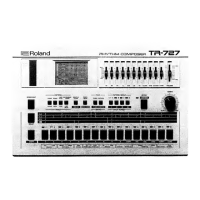7 OTHER
USEFUL
FUNCTIONS
FOR
EDITING
a.
Copying a single Pattern
A
Rhythm
Pattern
can be
copied fronn one memory
iocation to
another. After
copying,
the
Pattern
will
remain in its original location
as
well
as
apearing
in
the
new
location you
have
chosen.
Operation for
copying
Enter the Pattern Writing
mode.
(2)
Assign the
new
location
(Pattern Number)
which
your Pattern
is copied
to, by using Pattern
Group
Button (A, B,
C,
D)
and Pattern Number
Button
(Main Key 1
to
16).
(D
While
holding the Shift
Key
®
down, push the
Copy
Key
(Main
Key
11),
the Pattern
Group
Button
and Pattern
Number Button assigning
your source Pattern, then the Enter
Key.
It
is
not possible to
-copy
the Chained Patterns
altogether at
a
time. You
need to break
the
Chain once, then copy the pattern one
by
one.
Then finally chain
the
patterns
again. (See
p
29)
b.
Copy (in
Track Writing Mode)
You can
copy any Bar
or
sequence of Bars
into a
Track. The
arrival of
the
new
Patterns
will extend
the length of the
Track accordingly. The
difference
between COPY
and INSERT
is that
Insert
deals
with patterns
while
Copy adds
extra bars
from
an
existing
Track, either
within the
same
Track
or
a
different Track. To follow the Copying
procedure:
®
Enter the
Track Writing mode. Select
the
Track
you want
by
pushing
a Track Selector
Button.
(D
Assign
the bar
number after which
you
wish the
new pattern
to
begin,
by
holding the
Shift Key,
entering the bar
number and
pushing the
Enter
Key.
(D
While holding
the Shift Key,
push
the
Copy
(Main Key
11),
appropriate Main
Keys
(1
to
10)
assigning the starting
bar
number,
then the
Enter
Key, and the ending
bar
number, then the Enter
Key.
Be
sure that
all are
done while the Shift
Key
is
being held
down.
(See the
Example on
page
30)
NOTE
*
Please
make sure
that the
composer is not
run-
ning during the
above
Copying
operation.
*
Some copies are
impossible.
For example, you
cannot copy
Bars
20 to 25 into
Bar 22 of
the
same Track.
If
the
Copy
is
impossible, or
memory
is
full
(exceeding
998
bars) the Display
will respond with:
28

